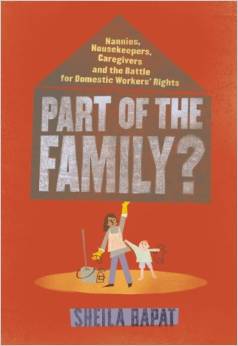Domestic Workers, Domestic Cargo

The word “slavery” has been so thoroughly abused in the context of American political discourse, that it’s easy to forget that it still means something, even in a nation that ostensibly abandoned the practice a century and a half ago. Yet when Sheila Bapat uses the word in her new book Part of the Family? Nannies, Housekeepers, Caregivers and the Battle for Domestic Workers’ Rights (IG Publishing, 224 pages, $16.95) to describe working conditions for thousands of American domestic workers, she’s not exaggerating.
Take the story of domestic worker Shanti Gurung, who Bapat says was “denied food, forced to sleep on the floor . . . and made to work more than sixteen hours per day” by her New York-based employer, the Maholtra family. That’s undeniably hideous, but what really takes Gurung’s case into the realm of slavery is the ways in which the family systematically blocked any means of escape. According to Bapat, the Maholtras “hid Shanti’s passport and visa, prohibited her from calling her family in India, and told her repeatedly that if she ran away, Homeland Security would rape her, torture her, and ‘ship her back to India like cargo.’”
If Gurung’s story is particularly extreme, it is not unprecedented. Domestic workers lack many of the basic legal protections enjoyed by the American workforce writ large. Until relatively recently, they weren’t even covered by the Fair Labor Standard Act’s minimum wage protections. And while domestic workers are slowly winning more rights through legislative battles across the country, the nature of housework makes those rights difficult to enforce.
 It should come as no surprise that about 90 percent of domestic workers are women. Housework has always been feminized labor in the United States, meaning that nearly everyone with some sort of stake in reproducing patriarchy—whether it be legislators, employers, or a household’s pater familias—has found good reason to distinguish it from of “real” work. Changing working conditions in the industry means changing how domestic labor is valued, Bapat argues.
It should come as no surprise that about 90 percent of domestic workers are women. Housework has always been feminized labor in the United States, meaning that nearly everyone with some sort of stake in reproducing patriarchy—whether it be legislators, employers, or a household’s pater familias—has found good reason to distinguish it from of “real” work. Changing working conditions in the industry means changing how domestic labor is valued, Bapat argues.
In that sense, the problem of domestic labor is not so different from the problem of the American service economy as a whole. Women predominate in all kinds of low-wage service industries, not just domestic work. And as with labor which takes place within the home, much of the work these women do is considered to be without real economic value. The plight of the domestic workforce is just a particularly extreme example of an economy-wide trend.
The fast food industry is another example of the same set of problems. As with domestic labor, women predominate in fast food service, one of the lowest-paying occupations in the United States (PDF). And although fast food service occurs outside the home, opponents of raising the industry’s wage floor tend to revert to a similar argument regarding the value of a fast food job. “Flipping burgers” isn’t a “real” job; it’s a summer gig for teenagers, or for the profoundly lazy.
Or, as Seattle radio personality Dori Monson put it last year:
Mindless minimum wage jobs are not a career. You’re not supposed to be able to raise a family of four on your minimum wage job. They were never designed to provide a ‘living wage’ (the nonsense phrase that trendy progressives have come up with for this cause).
Putting to one side the question of what fast food jobs are “supposed to be,” there’s no question that the industry employs a lot of parents and guardians. An August 2013 white paper (PDF) from the Center for Economic and Policy Research reported that just 30 percent of all fast food workers are teenagers, and over a quarter of people employed in the industry have at least one child. In addition, 52.6 percent of fast food employees are women, versus 47 percent of the overall workforce.
Most fast food workers aren’t kids trying to make a few extra bucks. They’re people, mainly women, in search of a full-time job to support themselves and the other members of their households. The work they do isn’t considered “real” in the same way that housework isn’t “real.” It’s labor that is being consciously devalued in order to suppress wages. Old-fashioned patriarchal assumptions about who needs a real income or a career, and what counts as real work, help facilitate this devaluation.
There are other examples, particularly regarding the devaluation of tipped labor and the concerted PR campaign now being waged against public school teachers. But the upshot is that women comprise a substantial majority of the country’s emerging service sector underclass. That’s why, as the White House’s economic team recently observed, 55 percent of the workers who would benefit from a federal minimum wage increase are women.
Discussing the domestic workers’ movement specifically, Bapat writes that it “conveys the message that domestic labor is worthy of dignity and respect,” and has made substantive policy strides as a result. Maybe the next step is to connect the struggle of workers in that industry to that of similarly marginalized workers in other corners of the service economy. Women don’t just make up a disproportionate segment of the working poor; they also dominate the leadership of some of the country’s most dynamic labor rights campaigns.
The current crop includes National Domestic Workers Alliance head Ai-Jen Poo, Restaurant Opportunities Center United co-founder Saru Jayaraman, Chicago Teachers Union president Karen Lewis, and fast food worker-organizer Naquasia LeGrand. Slowly but surely, these women and others like them are pushing back against the American economy’s relationship with low-wage, traditionally feminized work.